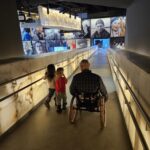I have been writing and speaking publicly a lot lately on the accessibility of air travel. The media, both nationally and internationally, has been filled with disturbing descriptions of the poor treatment of disabled travelers. Frankly, my contribution to the discussion has been highly critical of the industry and its regulators.
I have been described as a stubborn optimist. With that in mind, I came to the space to look at the positives for people with disabilities in the airline industry. There are some. In Canada, regulators have stepped in to impose heavy fines on carriers who have mistreated or disrespected their passengers. In the United States, this topic is being discussed at the highest levels of government in the Department of Transportation and in the office of the Vice President. I have been told by those in the industry that several manufacturers are designing new blended-wing aircraft which provide much more cabin space and flexibility around accessibility. At a grassroots level, advocates are joining together in movements such as #RightsOnFlights and #PassengerRights to put pressure on the industry to improve.
Yet these positives seem to have little impact on the day-to-day experience of disabled travelers. Travelers are still required to endure uncomfortable and potentially dangerous transfers to board an aircraft. Expensive, customized mobility equipment must be surrendered to the baggage hold for transport. Those of us with mobility disabilities are not provided access to a usable toilet.
Despite some positive changes, the everyday struggles of disabled travelers persist, showing the need for everyone—the industry, governments, and the community—to work together on practical solutions that aren’t kilometers away.
Photo: Daria Jorquera Palmer




